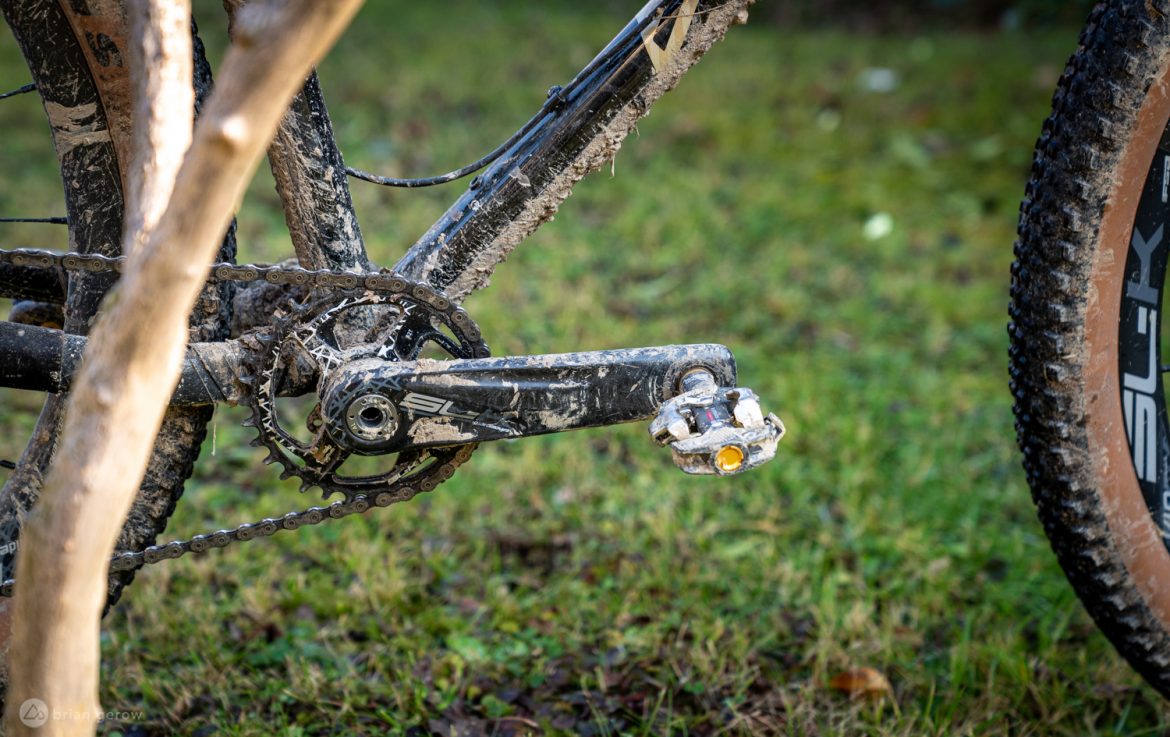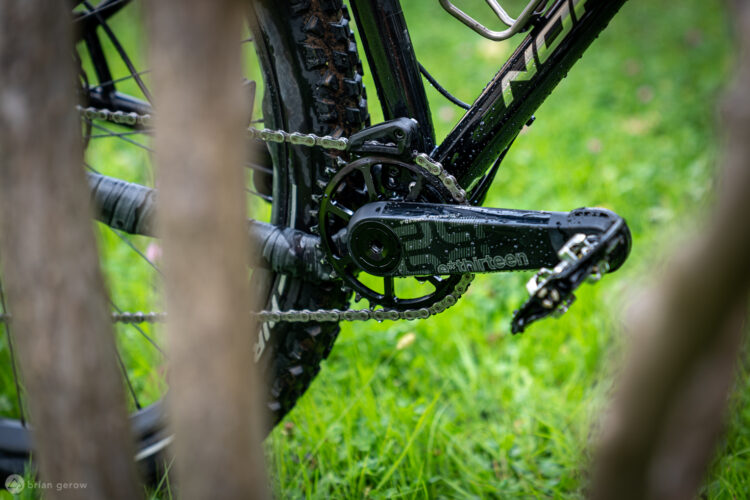
Not all weight weenies are created equal. Some of us expect that our lightweight gear be designed to withstand more than what traditional XC races and riding styles demand. When weight and durability commingle at the top of a product designer’s priority list the price typically doubles. After seeing a set of Full Speed Ahead SL-K carbon cranks on the Sunn Kern of French enduro master Kevin Miquel, my interest in the featherweight sticks was piqued.
A 170mm set of Full Speed Ahead SL-K carbon fiber 1X cranks with a 32t chainring weighs very close to the reported 517g on the brand’s website, and their MSRP sits at a cool $451.50 before any deal hunting. While that’s not exactly a budget-friendly number, the Shimano XTR M8120 cranks we reviewed last year weighed 515g, with a retail price tag of $549.99. These carbon cranks eat a little less cash at essentially the same weight, and they use a thicker spindle and more ample bearings than the alloy XTR set, which is intriguing.

The SL-K crankset can be ordered in 170 or 175mm lengths, with 30 or 32t chainrings. There’s also a double chainring version for folks who still prefer to fiddle with front derailleurs.
Each of the carbon cranks is hollow, similar to the alloy cranks of the XTR set mentioned above. The forged 30mm alloy spindle and CNC’d chainrings are both made of forged 7050 aluminum to keep the weight low and power transfer high.


Mounting the cranks up took a matter of minutes. I didn’t have the right adapter to install the large BB cups, but a standard strap wrench worked just fine to tighten them in place. From there I greased the spindle and slid the non-drive-side crank into the BB. The drive-side arm is cinched down with a 10mm hex key, and swapping the direct-mount chainring is wicked quick since you don’t have to remove the full crankset. With the proper amount of BB spacers, a wave-washer on the non-drive-side takes up any tiny intolerances in the system. Component installs really don’t get simpler than this.

Sometimes, things can be too easy. Or, more accurately, I can be impatient. I didn’t bother with a torque wrench the first time I tightened these cranks, and the drive-side arm came loose on the trail about two hours away from home. I didn’t have a 10mm wrench available, but I was able to wedge two of the largest wrenches on my multi-tool side-by-side into the 10mm hole and tighten it enough to pedal back home. I cinched it down to the required torque spec as soon as I arrived home and it has remained tight since.


FSA says that the included chainring is designed for Shimano 11-speed chains or SRAM 11 and 12-speed systems. They are still working on the perfect tooth profile for Shimano 12-speed chains, but I decided to take a chance and see if the teeth would cooperate with my Shimano M7100 12-speed chain. After several hundred miles of circles, I haven’t heard a peep from the drivetrain, and the ring’s varied-width teeth have plenty of life left. My chain-checker says that the links are about due for a replacement, which was expected given the amount of time I’ve spent on this bike over the fall and winter.
On the other important functionality notes, the SL-K crankset feels every bit as stiff as the metal XTR cranks. I don’t weigh enough nor dump enough watts to make either set flex, and they both transfer my toaster-powering pedal stroke with aplomb. Having smacked the carbon crank arms on a handful of things, I am impressed with their overall durability. I’d definitely throw them on my gravity bike and go smash through some rock gardens without fear of a broken arm, though I would prefer not to. This might be the point where Kevin Miquel and I diverge. Without a sponsorship to replace them, I would prefer to run DH-designed cranks on most long-travel bikes, and keep the lightweight carbon for bikes that see a little less heinous trails.
Finally, these cranks, chainring, and BB have been middle-of-nowhere silent no matter how long I stand and climb after slopping through the mud. I haven’t been kind to them by any means this winter, and they have returned nothing but silent reliability and durability. If they were a human friend I’d owe them hugs and several rounds of their favorite drinks. Since they’re cranks I’ll give them a good wash and spindle greasing.

If you’re comfortable with featherweight carbon fiber rotating close to the trail, and you want to shave some serious grams, the SL-K crankset is worth close consideration. For folks who change chainring sizes often, or who ride in wet conditions frequently and need to air out the ol’ BB hole, the install and removal process is a definite boon. Stay tuned for our full review of the FSA SL-K WidR25 carbon wheels in the near future.





















2 Comments
Feb 19, 2021
As for the product, talk about zero ankle clearance? They bother to make the spindle interface to the arm super wide but then still rely on a wavy washer? Please for the love of bikes use a threaded collar.
Feb 23, 2021
Brian, one demerit for not tightening the crank arm sufficiently.